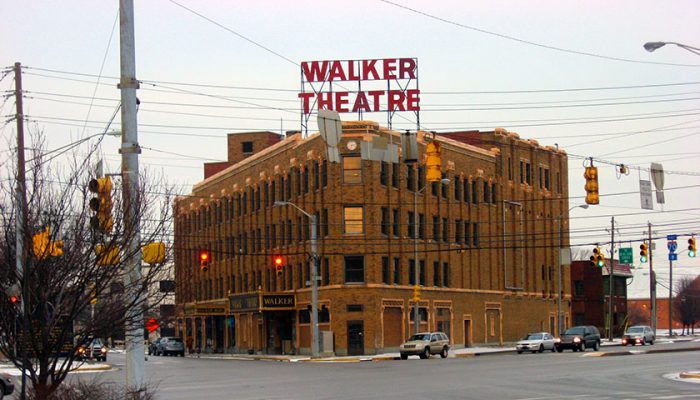
It was once the headquarters of one of America’s first Black woman millionaires. Today, the Madam Walker Theatre Center, a cherished relic from a bygone era of Indianapolis Black culture, is getting a major makeover.
The 90-year-old downtown landmark that housed her empire is still located at the corner of Indiana Avenue and Martin Luther King Jr. Street. It’s a charming venue stuck in time. The theatre’s décor is Egyptian and West African. Heads of sphinx flanked both sides of the stage and there are two carved chimpanzees that sit high above it. Small elephant heads adorn the theater’s ceiling and battle shields serve as light covers.
But despite its rich past, the theater has struggled in the present; the theater’s future remains uncertain, as well. It lacks air-conditioning and other modern amenities. In January, the landmark suffered severe damage when water pipes burst, flooding parts of the historic structure.
“It’s been a huge challenge, with the cold temperatures,” Joyce Rogers, chairwoman of the theater’s board in a story in the Indianapolis Business Journal. “You had water up to your ankles, and we had staff here until 2 to 3 o’clock in the morning taking water out in buckets.”
But in January, the Lilly Endowment Inc., a private foundation, announced that it would award the center a grant for more than $15 million, which will fund a complete renovation to cement its future for generations. The project will include exterior improvements, a new mechanical system, and upgrades to the theater’s sound system. The project is expected to be complete in July 2019.
The announcement coincided with an announcement from Indiana University, which pledged to partner with the facility to provide transitional operational support and develop new programming “to ensure the Walker’s sustainability and economic viability.”
Theater officials hope the three-way partnership will guarantee a brighter future for the venue, which has offered minimal programming in recent years. For 40 years, the Lilly Endowment has supported the theatre as a significant piece of history in the city.
“The theatre is one of the city’s truly authentic places,” Judith Cebula, the endowment’s communications director told the Journal. “It anchors a neighborhood with a very rich history.”
The Madam Walker Theatre Center is a triangular, four-story, 48,000-square-foot building, that houses a ballroom and several offices. The building was designed by the Indianapolis architectural firm of Rubush & Hunter, whose contributions to the city include the Columbia Club and the Hilbert Circle Theatre.
The building was once the national headquarters for the Madam C.J. Walker Manufacturing Co. It was named after the trailblazing Black businesswoman who built a hair grooming products empire in the early 1900s. Born Sarah Breedlove in Delta, Louisiana in 1867, she became an orphan when her father died in 1875. She moved to Vicksburg, Mississippi with a sister where she worked as a maid when she was just 10. Breedlove became Madam C.J. Walker after she married Charles Joseph Walker, her third husband; Walker was a newspaper advertising salesman she had known in Missouri. The two first formed the idea of the company in Denver, and then relocated to Pittsburgh before settling in Indianapolis in April 1910. On Indiana Avenue, she opened a hair salon in the home of Dr. Joseph H. Ward, the first Black doctor to head a Veteran Affairs Hospital in Indianapolis.
That summer, Walker’s operation officially became a company and, in five months, Walker had 950 sales agents and thousands of clients coming through the salon. Walker would go on to operate 200 beauty schools throughout the country.

Eight years after Walker’s death, the building, that still stands today, was completed in 1927 to help keep Walker’s empire going. According to Ebony magazine, the building housed the theatre, hair grooming products operation, a beauty shop and business offices. Today, it’s the last surviving iconic building on Indiana Avenue.
In 1980, the building was added to the National Register of Historic Places.
In December 1927, Walker’s daughter, A’Lelia Walker, finished the project in the year the first talking feature film, “The Jazz Singer,” debuted.
In its heyday, the theater showed movies and hosted vaudeville acts. Jazz greats such as Duke Ellington and Count Basie, played there and turned Indiana Avenue into a flourishing hub of Black culture.
When segregation laws gradually began to weaken in the late 1950s, middle-class Blacks traveled elsewhere for entertainment, leaving the once-bustling avenue for better opportunities in the northwestern part of the city. In 1965, the theatre closed. It was reopened in 1988, but it hasn’t been updated since.
“The building is really porous,” said Vop Osili, president of the Indianapolis City-County Council and a theater director. “You heat the building, and the people outside are warm.”
There are plans to install a new sound and audiovisual system and a new heating and cooling system. If more money is available, officials plan to install new carpeting, flooring and seats.
“We want it to be like it was in 1927,” Rogers, the theater board’s chairwoman, told the Journal.
After the makeover, the theater will be renamed the “Madam Walker Legacy Center.” Theater officials said that “Madam” will be spelled in the theater’s name without the traditional “e” because that’s how it appears in historical documents.



